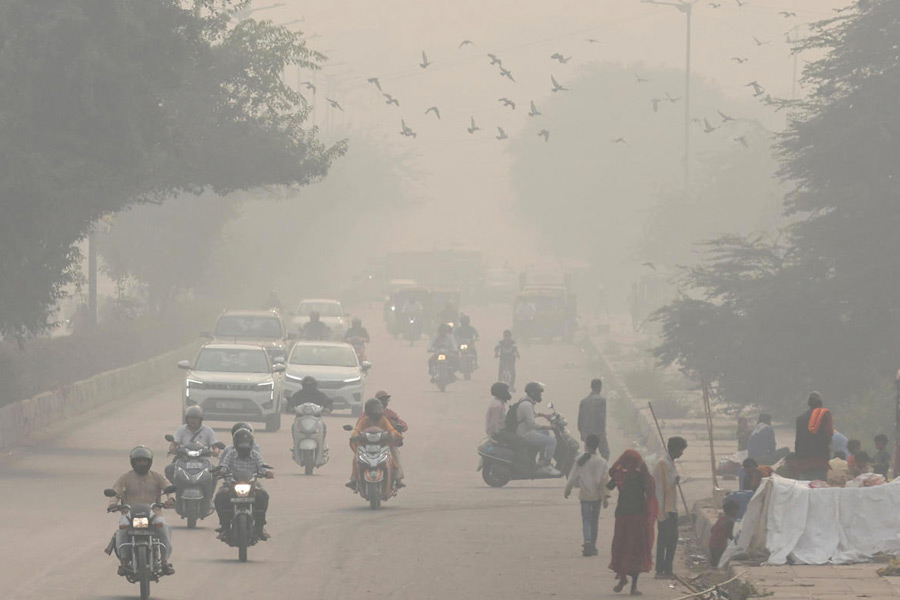Delhiites woke up to clear, blue skies and abundant sunshine on Saturday, marking a welcome relief from the suffocating haze that persisted for around two weeks.
At 7 am, the capital's air quality index (AQI) stood at 219, which is a marked improvement compared to Thursday's 24-hour average AQI of 437.
The notable improvement is attributable to intermittent rain over the last 30-32 hours and wind speed favourable for the dispersion of pollutants. The city experienced "very poor" to "severe" air quality for two weeks starting October 28.
Neighboring Gurugram (181), Ghaziabad (157), Greater Noida (131), Noida (148) and Faridabad (174) also recorded a significant improvement in air quality.
An AQI between zero and 50 is considered "good", 51 and 100 "satisfactory", 101 and 200 "moderate", 201 and 300 "poor", 301 and 400 "very poor", 401 and 450 "severe" and above 450 "severe plus".
The IMD had earlier predicted a marginal improvement in the air quality just ahead of Diwali, owing to favourable meteorological conditions, including light rain, under the influence of a western disturbance.
The western disturbance led to rain over most parts of northwest India, including Punjab and Haryana, effectively reducing the contribution of smoke from stubble burning to Delhi's air pollution.
Once the western disturbance passes, the wind speed will increase to around 15 kilometres per hour on November 11 (Saturday) which will help disperse pollutants ahead of Diwali (November 12), an IMD official said earlier.
Last year, a decrease in stubble-burning incidents, delayed spells of rain, favourable meteorological conditions, and an early Diwali prevented the national capital from turning into a gas chamber following the festival of lights.
According to data from the Decision Support System, a numerical model-based framework capable of identifying the sources of particulate matter pollution in Delhi, stubble burning in the neighbouring states, particularly Punjab and Haryana, accounted for 38 per cent of the air pollution in the city on Wednesday. It was 33 per cent on Thursday and 17 per cent on Friday.
The data also shows that transport is another major factor, contributing 12 to 14 per cent to Delhi's foul air.
Vinay Kumar Sehgal, principal scientist at the New Delhi-based Indian Agricultural Research Institute, anticipated a reduction in farm fires in Punjab and Haryana for two to three days due to wet conditions following rainfall.
In view of the worsening air pollution, the city government is planning to induce artificial rain on November 20-21 through cloud seeding.
The Delhi government on Wednesday rescheduled the December winter break of all schools. The winter break will now be from November 9 to 18.
On Friday, Delhi Environment Minister Gopal Rai said the government has postponed the implementation of the odd-even car rationing scheme as there has been a notable improvement in the city's air quality due to the rain.
He said the government will review the air quality situation after Diwali and a call on the odd-even scheme may be taken if there's a sharp increase in pollution levels.
Rai had earlier said the scheme would be implemented in the city after the Supreme Court reviewed its effectiveness and issued an order.
On Tuesday, the apex court questioned the effectiveness of the Delhi government's car-rationing scheme, aimed at curbing vehicular pollution, and referred to it as "all optics".
Anticipating further deterioration of the air quality post-Diwali, Rai on Monday announced that the scheme, which permits cars to operate on alternate days based on the odd or even last digit of their registration numbers, would be enforced between November 13 and 20.
Doctors say breathing in the polluted air of Delhi is equivalent to the harmful effects of smoking approximately 10 cigarettes a day.
Prolonged exposure to high levels of pollution can cause or exacerbate respiratory problems such as asthma, bronchitis and chronic obstructive pulmonary disease (COPD) and dramatically raise the risk of cardiovascular disease, they said.
Stringent restrictions mandated under the final stage of the Centre's air pollution control plan for Delhi-NCR -- Graded Response Action Plan (GRAP) -- have also been implemented in the national capital.
The restrictions under stage IV of the GRAP, including a ban on all kinds of construction work and the entry of polluting trucks into Delhi, took effect on Sunday after the air quality in the city dropped to 'severe plus' (AQI above 450) levels.
The GRAP categorises actions into four stages: Stage I -- Poor (AQI 201-300); Stage II -- Very Poor (AQI 301-400); Stage III -- Severe (AQI 401-450) and Stage IV -- Severe Plus (AQI above 450).
Unfavourable meteorological conditions, combined with vehicular emissions, paddy-straw burning, firecrackers and other local pollution sources, contribute to hazardous air quality levels in Delhi-NCR during winters.
According to a Delhi Pollution Control Committee (DPCC) analysis, the city experiences peak pollution from November 1 to 15, when the number of stubble-burning incidents in Punjab and Haryana increases.
The air quality in Delhi-NCR has declined over the last two weeks due to a gradual drop in temperatures, calm winds that trap pollutants and a surge in paddy-straw burning across Punjab and Haryana.
Delhi's air quality ranks among the worst in the world's capital cities.
According to a report compiled by the Energy Policy Institute at the University of Chicago (EPIC) in August, air pollution is shortening lives by almost 12 years in Delhi.
Except for the headline, this story has not been edited by The Telegraph Online staff and has been published from a syndicated feed.












